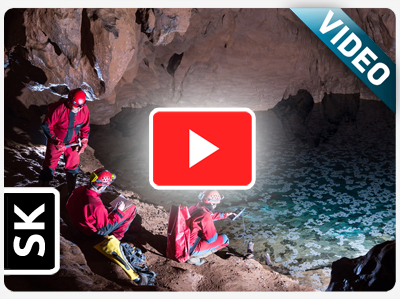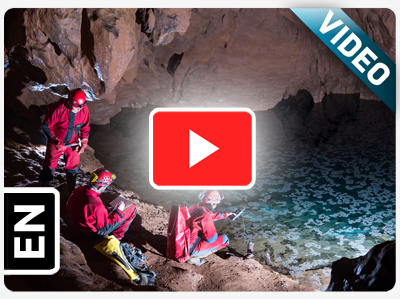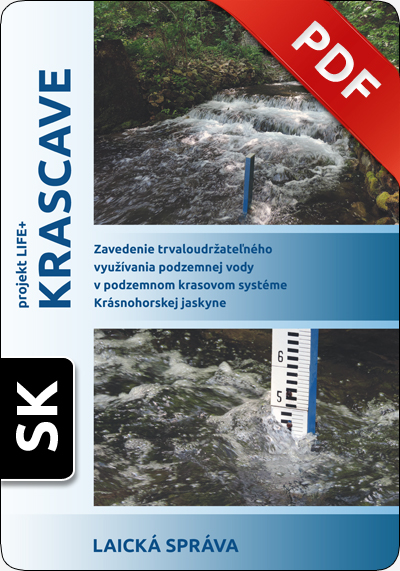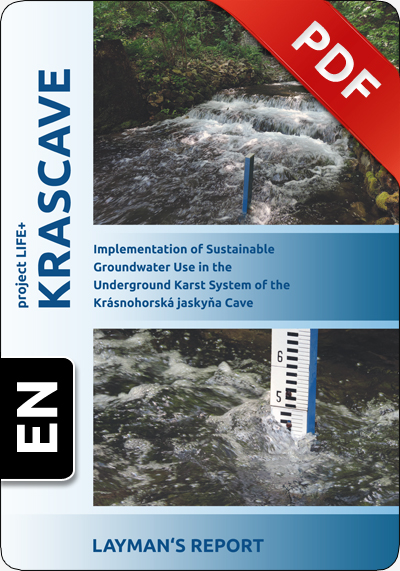About project
acronym: KRASCAVE
project code: LIFE+ 11 ENV SK 1023
project beneficiary: State Geological Institute of Dionýz Štúr
project period: 2012 - 2018
location: Slovakia / Eastern Slovakia
Introduction
After 1980, the territory of Slovakia and especially, to the greatest extent, on the territory of Slovenský kras Mts., a decline in natural groundwater resources was documented by up to 35% (Kullman & Chalupka 1995). Due to decrease in groundwater amount, as well as due to social changes after 1989, a change of landscape gradually started on the karstic plateaus. In particular, continuous and systematic decrease in the use of grazing causes gradual disappearance of permanent grassland and the onset of unwitting trees on grassland areas. A significant point is also disrupting of vegetation cover by forestry activities.
The area that is the subject of the KRASCAVE project is protected as part of the Slovenský kras / Slovak Karst National Park and in the underground as part of the World Heritage Site listed by UNESCO "Caves of the Slovak karst and Aggtelek karst".
In terms of groundwater occurrence is the vicinity Krásnohorská jaskyňa Cave, Silická planina plateau, as well as the entire territory of the Slovenský kras Mts. unique natural complex, characterized by extreme groundwater wealth, important also from the point of view of the water management. For this reason, a part of the National Park and its buffer zone was also declared to be a Protected Area of Natural Water Accumulation. Groundwater flow in kasrtified rocks is quite complex, infiltrated water initially retain the vertical direction, which is later changed to horizontal flow. A specific feature here is siphonal flow in open karstic conduits. Another important feature from the water protection point of view is that the delay – mean water transit time in the karstfied carbonate rocks since its infiltration until its appearance at the orifice of springs is less than 50 days in the majority of cases. The groundwater circulation can be generally divided into a shallow and deeper. Karst springs with shallow circulation are located at the foot of plateaus and are characterized by relatively high yield instability.
For the water supply of the Krásnohorská Dlhá Lúka municipality, groundwater pumped from well RHV-4 is exploited. RHV-4 borehole was drilled directly in front of the Buzgó karstic spring, not more than 30 meters from its orifice. Recharge area of the Buzgó spring was already investigated by tracer experiments with tracer introduction in the middle of the Silická planina Plateau. In the case of Žedem well and swallow hole, tracer test confirmed its relationship with underground flow of the Krásnohorská jaskyňa Cave. The same tests were conducted on wells and swallow holes of Rakaťa by cavers from Rožňava in 1967, with the same positive results. Krásnohorská jaskyňa Cave was discovered in 1964 through the orifice of the Buzgó karstic outlet, while reducing its water level. After intensive snowmelt and rainfall, water flows out here also through the manmade access corridor. The cave is verified in the length of 1355 m, while the main canyon corridor with active underground stream has a length of 520 m. In the upstream, the cave is terminated by a siphon through which in 1982 speleodivers managed to continue into the new unknown corridors, terminated by rock slide. Near the largest Buzgó springs, two smaller springs are to be found: Pod kameňolom (“Beneth the quarry”) spring and Pri kapličke (By the chapel) spring, which are supposed to be smaller side branches of the underground stream.
The whole territory of Silická planina Plateau is a part of the “Protected Area of Natural Water Accumulation” - protected water management area of the Slovenský Kras Mts. Protection areas (“zones of well-head protection”) of degrees I. and II. are delineated and declared for exploited groundwater sources. The quality of water in the past was namely influenced by the impact of agricultural production and its intensity. Nowadays, this is (mainly cattle and sheep breeding) much lower than in the second half of the last century. Statement of the area to be a National Park, organic farming in environmentally friendly agricultural schemes no longer allow the use of harmful pesticides and herbicides. Nonetheless, distortion of vegetation cover by forestry activities in the eastern part of the Silická planina Plateu still remains, thus threatening groundwater quality.
To ensure the sustainable use of the area by local residents, it is necessary to carry out preventive measures, targeted on protection of the most sensitive points of the karstic system.
In the vicinity of the Krásnohorská jaskyňa Cave (cave with a unique sinter decoration), the only prospectively available drinking water sources are found, with a potential of supplying the population in the immediate vicinity. Currently, the water source, which is the subject of the project, is used only for the needs of the population living in the village of Krásnohorská Dlhá Lúka. Its existence, quality and quantity of water is threatened and interferes with the natural processes of creating a unique flowstone. Within a year, the number of occasions on turbidity, presence of dirty water in the water source making the water unusable for drinking is registered.
Further continuation of the human activities around this precious source of drinking water in the present way endangers not only the quantity and quality of the water source for local residents, but is also risky for distortion flowstone formation.
To preserve drinking water source, together with preserving the flowstone and maintaining its sustained growing ability in the future, it is needed to design and implement a number of measures that are proposed in this project.

[KRASCAVE - location of the study area]
Project objectives and targets
By the implementation of project activities, positive impact on improving environmental quality can be expected by securing a high quality source of drinking water and an increased exploitable groundwater amounts, from the components of the environment water (groundwater) will be the most affected. Improvement of groundwater quality of may then naturally provide a positive impact on the adjacent protected area of the Slovak Karst / Slovenský kras Mts.
Mathematical modelling of rainfall-runoff interactions will contribute to the understanding of real processes in the natural environment, which represents the most important factor that can affect the decision making process of pollution sources elimination which provides a positive impact on the environment.
Measure of success of the project in relation to the expected impact on the environment and which can be used to monitor progress, however, is primarily the gradual improvement of physico-chemical parameters of groundwater in a given area of the Slovak Karst / Slovenský kras Mts. that can be quantified mainly nitrates contents, turbidity appearance frequency, the extent of bacterial contamination (the presence of Ecoli and coliform bacteria) as well as by TOC - organic substances.
In the framework of the project, system of protection of water resources in the form of measures will be designed to be implemented in different areas, by different stakeholders what we consider to be an innovative solution to a situation which is at present. In addition to the protection of water resources, a prototype device that will help to protect the water supply from the impact of turbidity will be installed on the groundwater source. This equipment is considered as the most innovative element of the project. This should be a device that has never been installed, and if the project demonstrates the effectiveness of protection against turbidity and improve the overall protection of water resources, this will be a good example for the installation of similar facilities around the karst area and not only in Slovakia but also in other countries similar problems in the use of water resources.
From the point of view of the significant water management solutions of the problems defined in the Slaná river sub-basin management plan, in relation to the requirements of the Water Framework Directive (WFD, Directive 2000/60 / EC), the project can help in activities to prevent deterioration and pollution of groundwater and thus significantly contribute to solving of these problems. Project activities will have an important impact in relation to the prevention of pollution of groundwater as the agricultural and industrial production (forestry), but also from the effects of pollution from households and tourism, as specified in the Slaná river sub-river basin management plan, particularly in identifying the point and diffuse sources of pollution. In terms of exploitable groundwater quantities may project contribute to the possibility of improved calculation of groundwater resources (under the Ministry of Environment Decree no. 51/2008 Coll.) on this particular site and then also to expand opportunities of water supply of the population of the region by good standard drinking water.
Project activities will contribute to higher density of groundwater quality monitoring network in the area, as required by the WFD directive, applied to the Slaná river sub-basin management plan, what will increase the reliability required assessment of groundwater status as a part of operational monitoring which is already performed in reduced form here.
Target groups
The most important target group of the project are the inhabitants of the Krásnohorská DLhá Lúka village and residents of other surrounding villages (Lipovník, Jovice, Hrušov, Hrhov Jablonov nad Turňou, Silica and Silická Jablonica). Information activities of the project will be focused on these residents, where principles of protection of water resources and sense of project activities will be explained in detail. As the most important participants, the youngest component of the local population is considered (pupils attending local nursery and primary schools), for which the project is aimed to raise their environmental awareness through lectures, discussions related to the screening of educational projections, professionally guided excursions, field trips and excursions.
5/5 : 1 Vote







